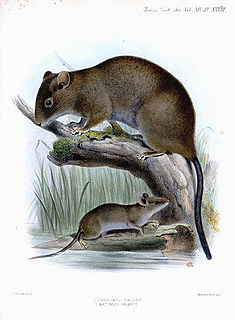Related Research Articles

The Chaetognatha or chaetognaths are a phylum of predatory marine worms that are a major component of plankton worldwide. Commonly known as arrow worms, about 20% of the known Chaetognatha species are benthic, and can attach to algae and rocks. They are found in all marine waters, from surface tropical waters and shallow tide pools to the deep sea and polar regions. Most chaetognaths are transparent and are torpedo shaped, but some deep-sea species are orange. They range in size from 2 to 120 millimetres.

Priapulida, sometimes referred to as penis worms, is a phylum of unsegmented marine worms. The name of the phylum relates to the Greek god of fertility, because their general shape and their extensible spiny introvert (eversible) proboscis may recall the shape of a human penis. They live in the mud and in comparatively shallow waters up to 90 metres (300 ft) deep. Some species show a remarkable tolerance for hydrogen sulfide and anoxia. They can be quite abundant in some areas. In an Alaskan bay as many as 85 adult individuals of Priapulus caudatus per square meter has been recorded, while the density of its larvae can be as high as 58,000 per square meter.
Collared wrigglers are perciform fishes in the family Xenisthmidae. They are native to the Indian and Pacific Oceans, where they are mostly reef-dwelling.
Eukrohniidae is a family of sagittoideans in the order Phragmophora. It consists of a single genus, Eukrohnia von Ritter-Záhony, 1909.

Batomys is a genus of rodent endemic to the Philippines. It has six described species.

María de los Ángeles Alvariño González was a Spanish fishery research biologist and oceanographer globally recognized as an authority in plankton biology. She was the first woman ever appointed as scientist aboard any British or Spanish exploration ships. She discovered 22 new species of marine animals and published over a hundred scientific books, chapters and articles. In her late career she studied the history of early marine scientific exploration.
Gnathifera is a clade of generally small spiralians characterized by complex jaws made of chitin. It comprises the phyla Gnathostomulida, Rotifera, Micrognathozoa, and Chaetognatha. It may also include the Cycliophora.
Platyhedylidae is a family of sacoglossan sea slugs, marine gastropod mollusks in the superfamily Platyhedylidae.
Kruppomenia is a genus of cavibelonian solenogaster, a kind of shell-less, worm-like, marine mollusk. One species is 2.5 mm long.

Sagittidae is a family of sagittoideans in the order Aphragmophora.

Aphragmophora is an order of sagittodieans in the phylum Chaetognatha.

Phragmophora is an order of sagittoideans in the phylum Chaetognatha.
Thomas Everett Thompson PhD DSc FZS was a British malacologist and embryologist, known for his extensive studies on opisthobranch molluscs.
Krohnittellidae is a family of sagittoideans in the order Phragmophora. It consists of one genus, Krohnittella Germain & Joubin, 1912.
Bathybelidae is a family of sagittoideans in the order Aphragmophora. It consists of a single genus, Bathybelos Owre, 1973, which consists of a single species, Bathybelos typhlops Owre, 1973.
Pterokrohniidae is a family of sagittoideans in the order Aphragmophora. I consists of a single genus, Pterokrohnia Srinivasan, 1986, which consists of a single species, Pterokrohnia arabica Srinavasan, 1986.
Spadellidae is a family of sagittoideans in the order Phragmophora. Spadellidae prey on plankton and commonly reside in the epipelagic zone of the ocean.
Heterokrohnia is a genus of chaetognaths in the family Heterokrohniidae.
King's worm lizard(Amphisbaena kingii) is a species of worm lizard in the family Amphisbaenidae. The species is endemic to South America.
Hemispadella is a genus of chaetognaths in the family Spadellidae. It consists of one species, Hemispadella dauvini Casanova, 1996. The species, as the generic name implies, shares numerous, but not all, of the characteristics of Spadellidae; it shares a number of other characteristics with Heterokrohniidae. The ventral ganglion, poorly described in chaetognaths, is of similar size to the Heterokrohniidae, and the larger number of teeth, and the difference in appearance and function between the anterior and posterior teeth, are similarly characteristic. The relative tail size is similar to that of the Spadellidae, although the overall size is unprecedented among the Spadellidae. The more developed nature of transverse musculature and the basis for the lateral fins are as those of Spadellidae, as well.
References
- 1 2 3 4 von Salvini-Plawen, L. (1986). Systematic notes on Spadella and on the Chaetognatha in general. Zeitschrift für Zoologische Systematik und Evolutionsforschung, 24(2), 122–128.
- 1 2 Bowman, T. & Bieri, R. (1989). Paraspadella anops, new species, from Sagittarius Cave, Grand Bahama Island, the second troglobitic chaetognath. Proceedings of the Biological Society of Washington, 102(3), 586–589.
- ↑ Tokioka, T. (1965). The taxonomical outline of Chaetognatha. Publications of the Seto Marine Biological Laboratory, 12(5), 335–357.
- ↑ Casanova, J. (1990). A new species of Paraspadella (Chaetognatha) from the coastal waters of Japan. Proceedings of the Biological Society of Washington, 103(4), 907–912.
- 1 2 Mawson, P. M. (1944). Some species of the chaetognath genus Spadella from New South Wales. Transactions of the Royal Society of South Australia, 68, 327–333.
- ↑ Alvariño, A. (1981). Spadella legazpichessi, a new benthic chaetognath from Enewetak, Marshall Islands. Proceedings of the Biological Society of Washington, 94, 107–121.
- 1 2 Owre, H. B. (1963). The genus Spadella (Chaetognatha) in the western North Atlantic Ocean with descriptions of two new species. Bulletin of Marine Science, 13, 378–390.
- ↑ Alvariño, A. (1987). Spadella pimukatharos, a new benthic chaetognath from Santa Catalina Island, California. Proceedings of the Biological Society of Washington, 100, 125–133.
- ↑ Conant, F. S. (1895). Description of two new chaetognaths: Spadella schizoptera and Sagitta hispida. Johns Hopkins University Circulars, 14(119), 77–78.